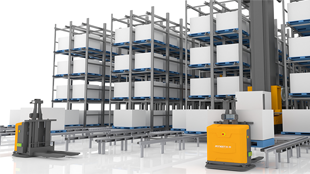Advantages of AMRs in AS&RS (Automated Storage and Retrieval System)
In the context of AS&RS , where storage density and operational efficiency are critical, AMRs have emerged as transformative solutions. These intelligent unmanned forklifts are specifically designed to address the unique challenges of vertical storage environments, offering significant advantages over traditional manual forklifts. |  |
|
Advantages Over Traditional Forklifts
1. Enhanced Safety
Operating in high-rise warehouses poses significant safety risks, particularly when using traditional forklifts. Human operators are susceptible to fatigue, distractions, and errors in judgment, which can lead to accidents such as collisions, tip-overs, or falls from height. AMRs, however, eliminate these risks through their advanced safety features.
They are equipped with 360-degree obstacle detection systems that can identify and avoid obstacles, including personnel, other vehicles, and infrastructure. Additionally, AMRs adhere strictly to pre-programmed routes and safety protocols, ensuring consistent and safe operation at all times. This not only protects workers but also reduces the risk of damage to goods and warehouse infrastructure.
2. Space Optimization
High-rise warehouses are designed to maximize vertical storage space, but traditional forklifts require wide aisles to maneuver, limiting the potential for dense storage. AMRs, on the other hand, are capable of operating in much narrower aisles.
Some AMR models can navigate aisles as narrow as 1.6 meters, thanks to their precise steering and positioning capabilities. This allows warehouses to increase their storage density by up to 50%, making more efficient use of valuable floor space. By minimizing the need for wide turning radii, AMRs enable warehouses to store more goods in the same footprint, reducing the need for costly expansions.
3. Operational Efficiency
AMRs offer unmatched operational efficiency compared to traditional forklifts. They can operate 24/7 without breaks, shifts, or downtime for rest, ensuring continuous material flow in the warehouse. This consistency is particularly valuable in high-rise warehouses, where the vertical nature of storage can make operations more time-consuming.
Moreover, AMRs are programmed to follow optimized routes and schedules, minimizing travel distances and idle time. They can also prioritize tasks based on urgency, ensuring that critical orders are fulfilled promptly. This level of automation and precision leads to significant improvements in throughput and order fulfillment rates.
4. Cost Savings
While the initial investment in AMRs is higher than that of traditional forklifts, the long-term cost savings are substantial. AMRs reduce labor costs by eliminating the need for human operators, who require salaries, benefits, and training. Additionally, they minimize operational costs associated with accidents, such as equipment damage, product loss, and downtime.
AMRs also have lower maintenance requirements compared to traditional forklifts. Their automated systems are designed for predictive maintenance, which can identify and address potential issues before they lead to breakdowns. This reduces maintenance costs and extends the lifespan of the equipment.
5. Scalability and Flexibility
High-rise warehouses often need to adapt to changing business needs, such as fluctuations in inventory volume or shifts in product demand. AMRs offer exceptional scalability and flexibility in these scenarios.
Warehouse operators can easily add or remove AMRs from their fleet as needed, without significant disruptions to operations. Additionally, AMRs can be reprogrammed quickly to accommodate changes in warehouse layout or workflow. This adaptability makes AMRs a future-proof investment for high-rise warehouses, ensuring that they can remain competitive in a rapidly evolving market.
6. Data-Driven Insights
AMRs generate a wealth of data about their operations, including travel times, task completion rates, and energy consumption. This data can be analyzed to identify inefficiencies, optimize workflows, and make informed decisions about warehouse management.
For example, by analyzing travel patterns, warehouse operators can identify bottlenecks and adjust routes to improve flow. Data on energy consumption can help optimize charging schedules, reducing downtime and energy costs. This data-driven approach to warehouse management allows for continuous improvement and ensures that operations are as efficient as possible.
In high-rise warehouses, AMRs offer a comprehensive solution that addresses the limitations of traditional forklifts. Their advanced working principles, combined with superior safety, space utilization, operational efficiency, cost savings, scalability, and data-driven insights, make them indispensable for modern logistics operations. By investing in AMRs, high-rise warehouses can achieve higher productivity, improved safety, and a competitive edge in the global market.